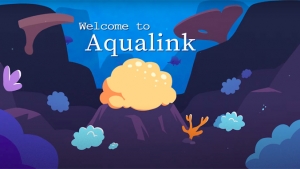A University of Hawaiʻi collaboration produced an animation video to explain complicated Smart Buoy technology.
John H.R. Burns, a UH Hilo marine science assistant professor and founder of the MEGA Lab, is collaborating with Aqualink to test and deploy its Smart Buoy system and develop protocols to help monitor its coral reef areas. Burns also helped to develop inter-disciplinary data visualization courses with support from the Academy for Creative Media (ACM) at UH Mānoa and UH Hilo.
Burns said he had several discussions about the usefulness of animations to explain complex scientific topics with UH Mānoa ACM Assistant Professor Brittany Biggs, including using animation as a user guide for people receiving the Aqualink Smart Buoy system to help track ocean temperatures and coral bleaching.
Burns collaborated with ACM animation alumni Kalilinoe Detwiler, Gavin Arucan and Alexis Nelson to produce the video. Detwiler said that after receiving guidance from Burns and Aqualink, the team followed a production pipeline and used shot breakdown sheets from their ACM courses. They also used programs such as Adobe Photoshop, Adobe After Effects, TVPaint and Adobe Premiere Pro.

“My favorite part of this project was seeing the direct benefit of art and design to enhance science,” Burns said. “ACM has provided excellent opportunities for students throughout the UH system and really showcases the power of combining art and science. I think this project is a great reflection of that investment and goal, and shows how the skills our students develop can be applied to an array of industries.”
Burns added, “Gavin, Kalilinoe and Alexis were very professional and a pleasure to work with. The final product was excellent and the team at Aqualink are thrilled to have an animation how-to guide.”
Detwiler said working on the project was a great team experience and looks forward to more opportunities to integrate the different disciplines.
“When science and art, or any two disciplines, begin to collaborate, we are pushing traditional disciplinary boundaries and creating something unique that is based within two different schools of knowledge,” Detwiler said. “Animation was a great way to make the Aqualink system visually accessible for its users. I look forward to cross-disciplinary projects between STEM and art programs.”
—By Marc Arakaki

